Unit 11: Research Project Submission
26 Pages8881 Words293 Views
Added on 2021-08-06
Unit 11: Research Project Submission
Added on 2021-08-06
ShareRelated Documents
1
ASSIGNMENT 2 FRONT SHEET
Qualification BTEC Level 5 HND Diploma in Business
Unit number and title Unit 11: Research Project
Submission date 29/12 Date Received 1st submission
Re-submission Date Date Received 2nd submission
Student Name Le Duc Huy Student ID GBD18452
Class GBD0704 Assessor name Van Hung Trong
Student declaration
I certify that the assignment submission is entirely my own work and I fully understand the consequences of plagiarism. I understand
that making a false declaration is a form of malpractice.
Student’s signature huy
Grading grid
P3 P4 P5 P6 P7 M2 M3 M4 D2 D3
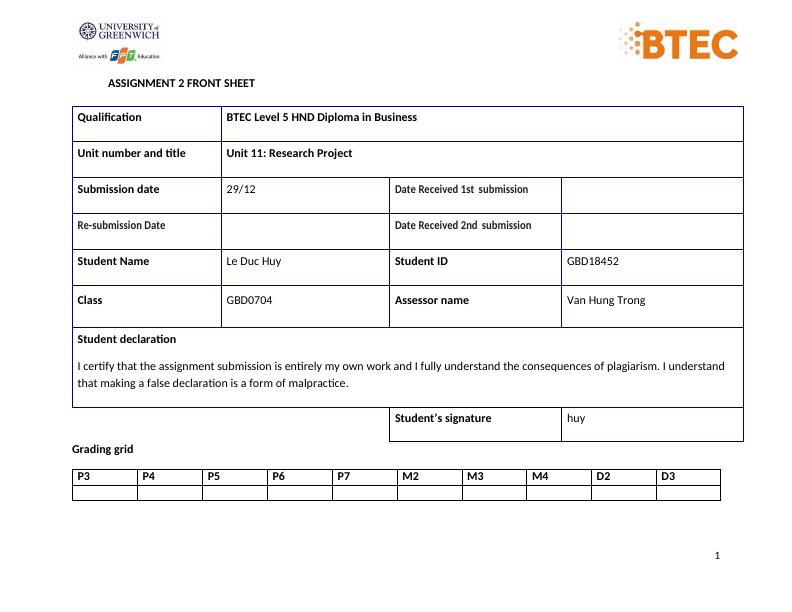
Summative Feedback: Resubmission Feedback:
Grade:
Assessor Signature:
Date:
Internal Verifier’s Comments:
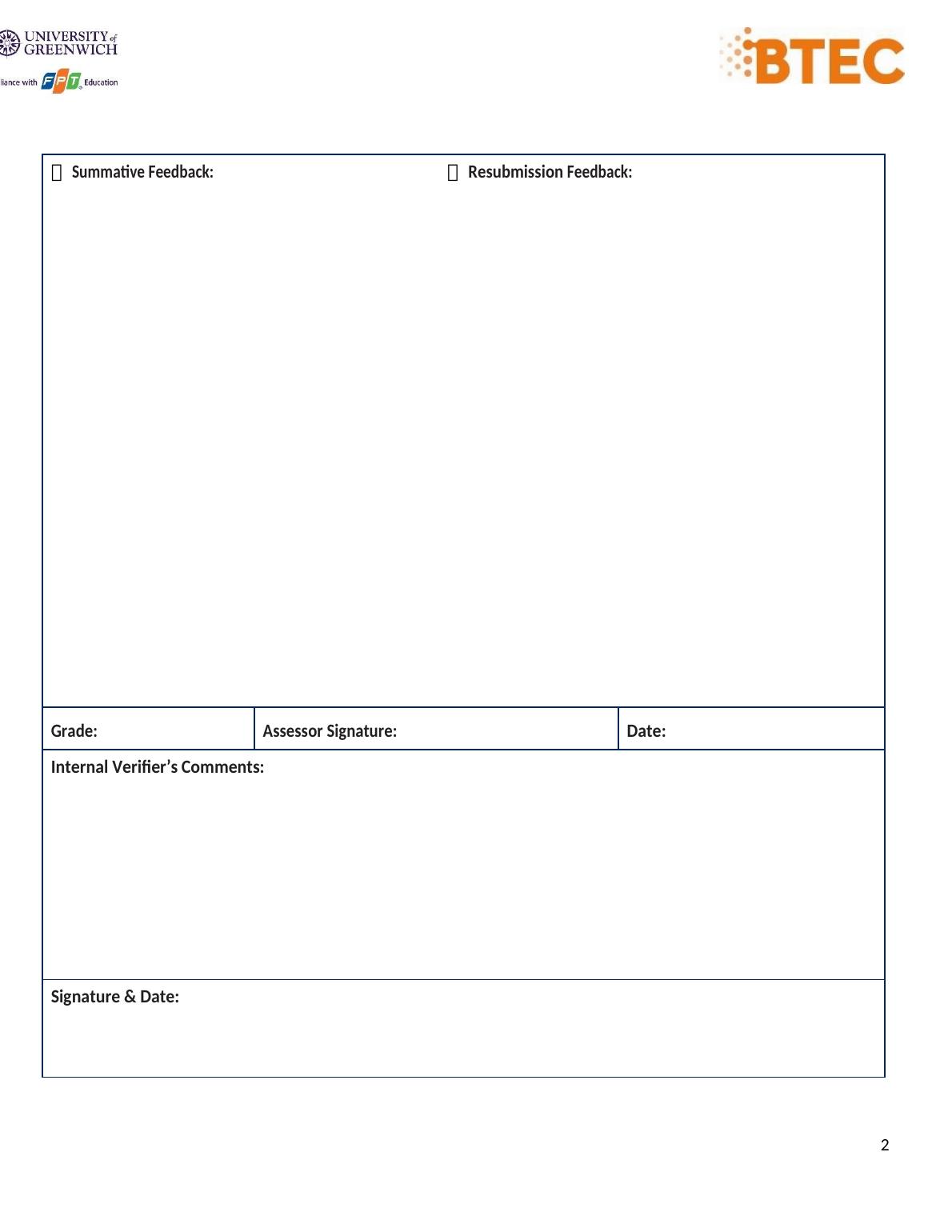
Table of Content
I. Introduction ................................................................................................................................................................ 4
II. LITERATURE REVIEW ................................................................................................................................................... 5
Conception .......................................................................................................................................................................... 5
III. Hypothesis and Research Model ............................................................................................................................ 6
Table 1: The descriptive statistics .................................................................................................................................... 10
Table 2: The Cronbach’s alpha. ........................................................................................................................................ 10
Table 3:The Exploratory Factor Analysis (EFA). ............................................................................................................... 10
Table 4:Model fit indices .................................................................................................................................................. 12
Table 5:The measurement model .................................................................................................................................... 13
Table 6:Discriminant validity ............................................................................................................................................ 13
Table 7: Structural paths assessment and hypothesis test ............................................................................................. 14
V. Conclusion ................................................................................................................................................................. 14
Limit ................................................................................................................................................................................... 15
VI. Implementation .................................................................................................................................................... 15
VII. Reference: ............................................................................................................................................................. 17
Appendix ........................................................................................................................................................................... 18
List of table
Attracting Talents ................................................................................................................................................... 6
Hypothesis 1 .......................................................................................................................................................... 6
Deploying Talents ................................................................................................................................................... 7
Hypothesis 2 .......................................................................................................................................................... 7
Retaining Talents .................................................................................................................................................... 7
Hypothesis 3 .......................................................................................................................................................... 7
Planning ................................................................................................................................................................. 8
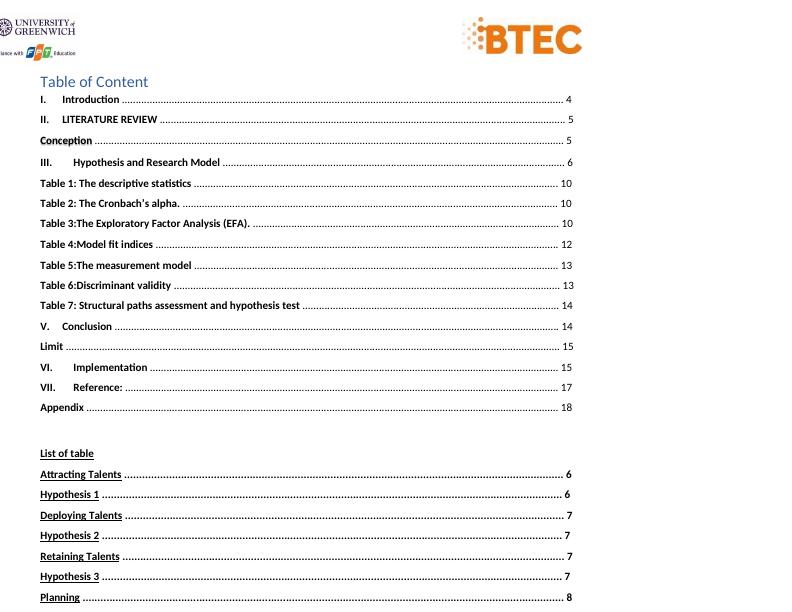
I. Introduction
Talent management is a comprehensive strategy for recruiting, training, employing and maintaining good
employees in the business. Talents are good people, with outstanding potential in an organization, an
enterprise, a field of business. ( Dooher & Marting, 1957 ) Organizations need to invest in proper utilization of
the talent for the advantage of the organization. In other words, organizations need to “Manage Talent”.
According to TS. John Sullivan 2019, in the top 4 of the world's leading accounting and auditing companies
including Ernst & Young, KPMG, Deloitte, PwC, whichever company has more effective talent management,
the revenue is higher than the rest. 18%. He also found that the senior personnel also bring added value to
the business. For every 1% of talented employees, they bring 10% of total revenue for the business, which is
10 times more than the average employee. And, the top 5% of employees bring 26% of total revenue, which
is nearly 5 times the average employee. The added value of talented personnel has many times changed
compared to the value of the average employee. The reason is:
Firstly, with the rapid development of digital technology and artificial intelligence repetitive, non-creative jobs
will easily be replaced by "robotic process automation". Robot process automation is a comprehensive term
used to define a set of technologies that organizations can use to automate both business and operational
processes. ( Robert E.Lewis, Robert J.Heckman ,2016 )
Second, cloud computing and the internet allow customers to find the best service and price without being
restricted by carriers located in different countries. This also results in the loss of advantages in products and
services due to rapid replication. Thus, businesses will always have to be creative if they want to thrive. And
only talented labor can create this value, so businesses will have to focus on this source of labor. However,
how to recruit highly qualified workers and "retain" them is also a difficult problem, especially when
advancement in information technology can allow them to work remotely - recruiting global.
Specifically, the issue related to Vietnam's aviation industry will be studied in this research paper. Specifically,
Vietjet Air in Da Nang, the participants are the officers and employees specializing in operating and working
in many departments of this company. Even so, engineers from all over the world are mostly Vietnamese.
Moreover, Vietjet Air is also a great English-speaking environment for cultures to exchange and build a vibrant
community. This distribution is made because in Vietnam, Vietjet Air's cultural diversity is very high and
recommendations should be made to prevent future clashes and maintain a comfortable working atmosphere.
roof has been done. A wide range of variables has not been thoroughly studied regarding the diversity of work
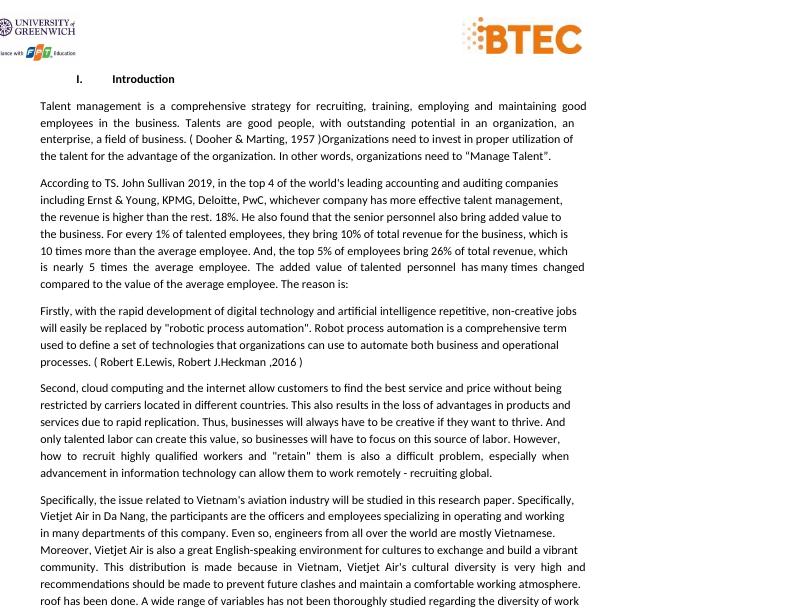
The main objective of this study is to use the analysis of Vietjet Air In Da Nang to provide managers with a
better understanding of how cultural diversity is present in the HR department. For one thing, this research
could help managers facing problems find approaches or ways to promote cultural diversity. This assessment
may be influenced by a number of external and internal considerations. It allows in-depth managers to
consider how processes and causes ultimately affect their final decision. This research can be very important
for those interested in discussing more of these topics. Analysis shows that the problems have been identified,
the various factors and solutions for managers and employees are assessed.
The three main questions used for this study can be considered as follows:
1) What are relationship between independent variables and successful talent management ?
2) What is the importance of talent development and the implementation of future plans affect the way talent
is managed ?
This investigation will be about cultural diversity in the working environment, of Vietjet Air in Da Nang.
However, this study does not guarantee the most accurate accuracy because it is located in a company with a
small number of employees, so some of the details in the study will not be strong. Furthermore, the study was
conducted over a two-month period, from November 12, 2020 to December 31, 2020. As there is such a brief
amount of time, it is not feasible for the inquiry to cover and show that the conclusion is right. The findings
can however differ, and this analysis will be split into many sections. The first is about the interpretation of
the thesis, including the basis, reasons for selecting the topic, priorities, research questions, scope, significance
and methodology. Subsequently, all of the terms and Greek relevant to the management of cultural diversity
and concub variables will be clarified in a literature review. Last but not least, research would be used in order
to recognize factors affecting the management of cultural diversity as real or incorrect and draw fair
conclusions in the end.
This research is intended to provide a clearer understanding of how to handle cultural diversity of their
businesses to managers in the organisation. Not only that, but analysis also lets students learn how to perform
surveys and recommend responses to topics that emerge. Last but not least, in order to explore cultural
diversity in the workplace, the research offers information for prospective testers, in this case a small business,
Vietjet Air. Data were gathered for further review without the absence of a crucial element in several different
fields related to cultural diversity. Finally, it can be used to assess Data Analysis, Regression Analysis and
Descriptive Statistics using various approaches.
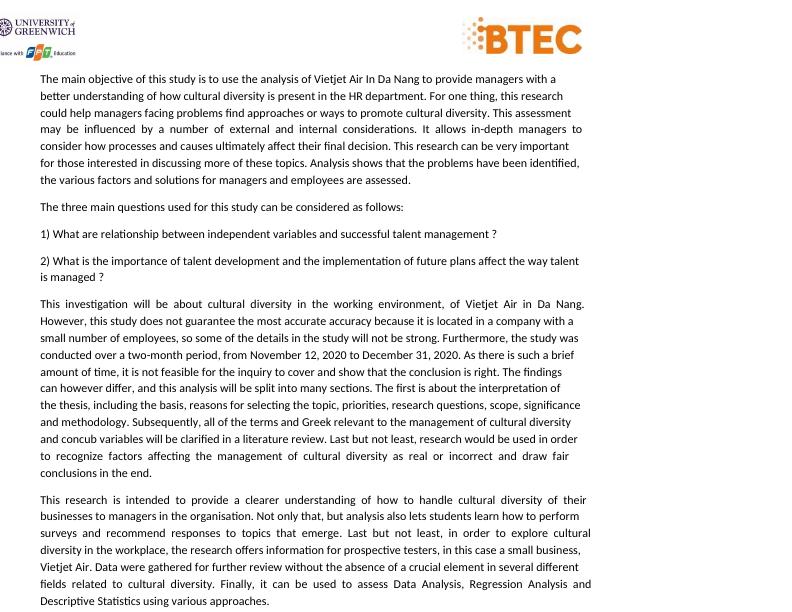
remains quite tenuous (Hughes &Rog, 2008). Stephenson & Pandit(2008) and several other researchers have
suggested that it is essential for talent management to have the right number of people in the right place at
the right time with the right skill sets and levels of motivation. Others believe that talent management fully
embraces the activities of an organization that attracts, develops, selects and retains (Stahl et al., 2007). Talent
management is characterized by CIPD as the coordinated attraction, distribution, growth and retention of high
potential workers who are perceived to be a certain asset for the company (CIPD, 2009, p. 2). Talent
management is active in all processes of human resource management (HRM) with a particular focus on
recruiting, cultivating and retaining talent (Lewis and Heckman, 2006). In another way, it can be claimed that
talent management covers nearly all facets of the management of human resources (Stewart & Harte, 2010).
Some others define talent management as an agreed and statutory promise to use a consistent, technical and
strategic approach to the management of human resources (Hughes &Rog, 2008). According to Iles et
al.(2010a) and Capelli (2008), talent management and HRM present a correlated theoretical base with
dissimilar analysis. The following graph will illustrate about the factors that put an influence on the managing
cultural diversity at workplace, in this case, at Vietjet Air.
III. Hypothesis and Research Model
Attracting Talents
Hypothesis 1
H1:There is a positive relationship between attracting talents and successful talent management in
Vietjet Air
The attractiveness to prospective expertise relies on the ideals of the company and how the prospective
applicants see the enterprise; it depends on whether the organization holds a high reputation in the new
market in which it exists or only struggles to survive. Therefore, one of the most critical and essential
challenges that can quickly draw external talents is the employer brand. It is clear that all the talents seek
growth and advancement; they cannot find it unless they look for high performance companies, which have
good reputation. This issue can be supported by some researcher’s quotes such as: The invention of an
attractive employer brand is a critical issue in attracting external talent (Iles et al., 2010a). Recruiting the
right people needs proactive HR thinking and Clever entry criteria formulation to pick the right talents (Pruis,
2011). There is a strong link between recruiting external talents and the 'employer image' (Glen, 2007). Some
assume that attracting and retaining talents based on the exclusive-people model are the two basic needs of
talent management (Iles et al., 2010a). Therefore, the first step that the talent management should focuson
is “talent pool”, which can be both internal and external to the organization. Thus, the “employer brand” and
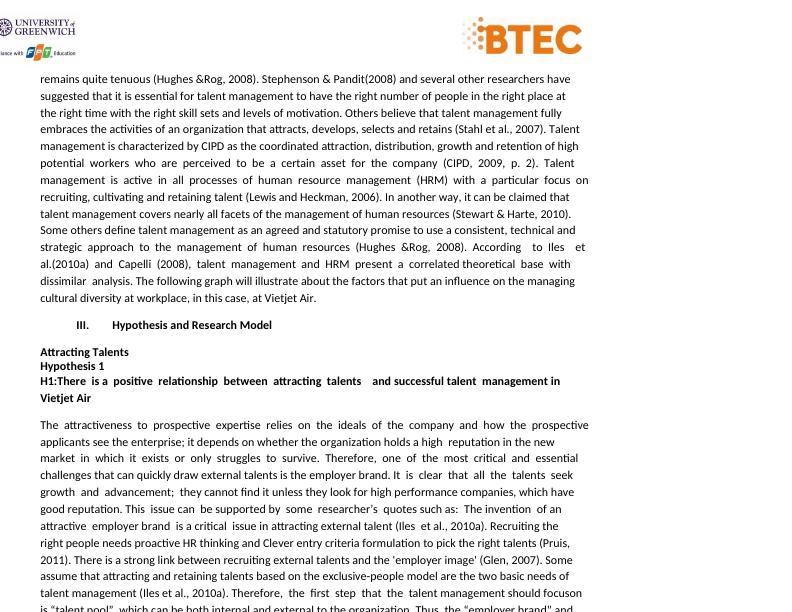
End of preview
Want to access all the pages? Upload your documents or become a member.
Related Documents
Management and leadership concepts Assignment 2022lg...
|37
|13202
|20
Unit 6: Management a Successful Business Projectlg...
|21
|5362
|90
Unit 12: Organizational Behaviorlg...
|10
|3377
|126
Assignment on the Front Sheet 2022lg...
|23
|5341
|23
Management a Successful Business Project Assignmentlg...
|26
|6655
|88
Unit 2 Marketing Planning and Processeslg...
|10
|2641
|52
